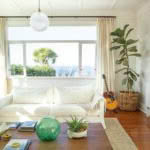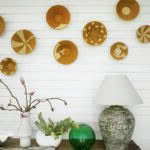The Longhouse has been a haven for a century – its latest owners are keeping the tradition alive
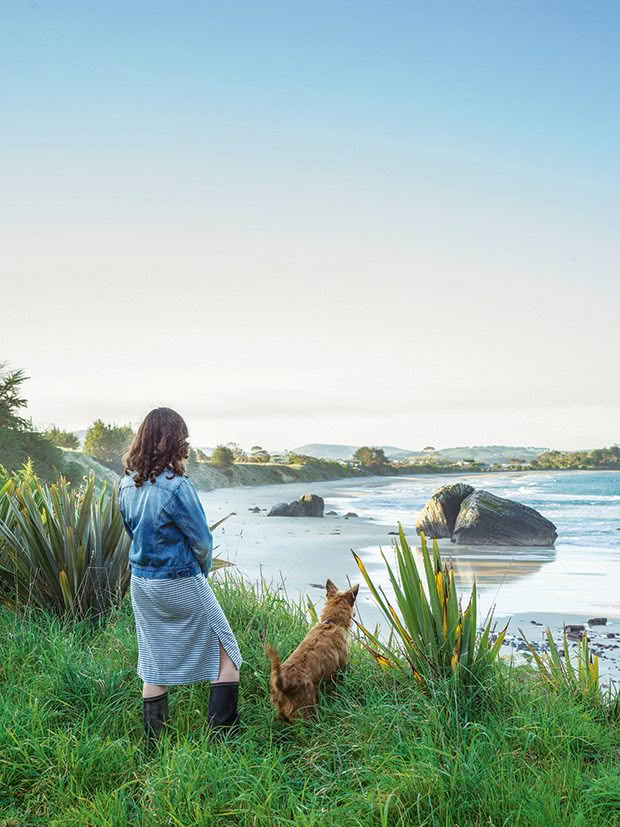
Ilse Erasmus and her dog Elmo look out from a neighbouring property over Karitāne Beach (a popular surfing spot).
Though modern-day guests at this coastal Karitāne retreat are far more coddled than the property’s first war-ravaged inhabitants, they’re still chasing the very same thing — good health.
Words: Claire Finlayson Photos: Rachael McKenna
This Karitāne house just cannot shake its virtue. It had therapeutic intent built into its very bones from the get-go, and now, almost a century later, the home has boomeranged back to its original health-buttressing function under the keen guidance of Ilse Erasmus.
The Longhouse Tirimoana Whare Roa has a name that speaks to its central virtues: expansive coastal views and luxurious architectural spread. The home’s first occupants fully deserved this, for they were newly returned World War I soldiers: shellshocked, battle-weary and needing sea-steeped, curative surrounds. The building’s orientation — six ocean-facing bedrooms all leading off a long verandah — ensured equitable view distribution for those war veterans and earned it that classic faux-exotic moniker, Bella Vista.
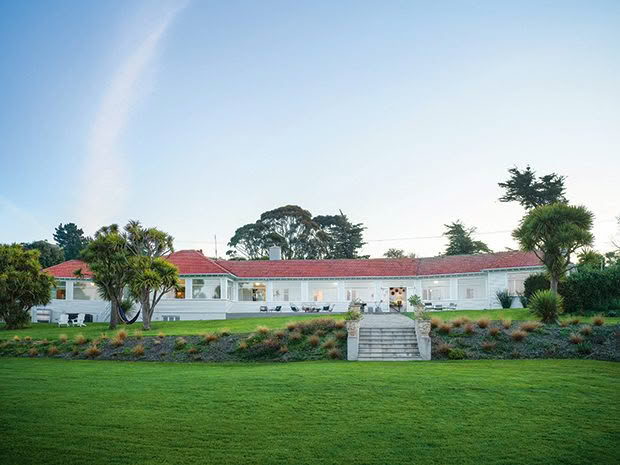
The home, viewed from the lawn, displays its 360 square metres of distinctive elongation.
The house was initially built as a “neuropathic hospital” in 1927 under the administration of Seacliff Mental Hospital (where health reformer Sir Frederic Truby King was superintendent for 30 years). “Truby commissioned it,” says Ilse. “He believed in the coastal atmosphere — that fresh air, exercise and connecting to nature was the path to healing and recovery. Patients could get into the garden, spend time on the beach and recuperate. Much research shows the influence of ‘getting your blue mind on’ near the coast. I think Truby was dead-on when he decided to set up Bella Vista for returning servicemen who came back shattered and disconnected. Even back then, they knew the ocean would be deeply therapeutic and restorative.”
Local lore has it that the property was also used mid-last century as a Karitāne nursing home for mothers with newborn babies (the first of the Plunket Society’s Karitāne hospitals was opened in Truby’s own holiday house on the nearby peninsula).

The Erasmus family enjoying a slow lunch of a frittata, slow-roasted tomatoes, salad, olives and gluten-free bread on the patio with the Otago coastline on picturesque backdrop duty yet again.
When The Longhouse came up for sale in 2021, this rich backstory of nurturance called loudly to Ilse. After having recently navigated her own health battle, she was newly attuned to the impact “place” can have on the body at a cellular, mental, and emotional level. “Primarily, it was Tirimoana’s location on this pristine part of the Otago coastline that appealed — but when I heard about its history, it was synchronicity. I rang Craig and said, ‘I think you need to come and look at this house.’”
Ilse, her husband Craig and their three children — Olivia, Margot and Vivienne —had moved from Marlborough to Queenstown in 2015, and it was while visiting two of her daughters at boarding school in Dunedin that she spotted The Longhouse in Karitāne, a small coastal settlement 35 kilometres north of the city.
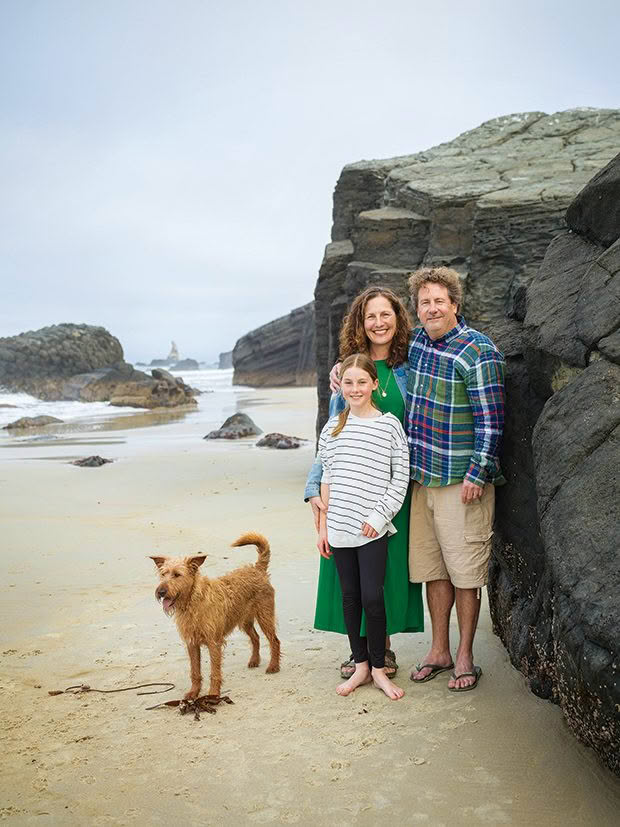
Ilse, her husband Craig, their youngest daughter Vivienne and Elmo at Karitāne Beach. “The beach is my daily medicine,” says Ilse.
The pull was instant. “Dunedin’s coastline is just so underrated. It has an ever-changing seascape: big swells and waves, millpond days, godwits, oystercatchers, penguins, seagulls — it’s beautiful. The whole Blueskin Bay area is a bit of a road less travelled.”
The charms of Karitāne weren’t new to them. “We used to go there and rent baches many years ago. I’d always loved this part of the coast. It’s the perfect counterpoint to Queenstown’s freneticism — a very exciting and beautiful place, but the mountains have a certain sort of frequency about them. I grew up in South Africa on the east coast and spent all my spare time by the ocean. I had this innate knowing that I needed to go back there. I was longing for horizons and blue space.”
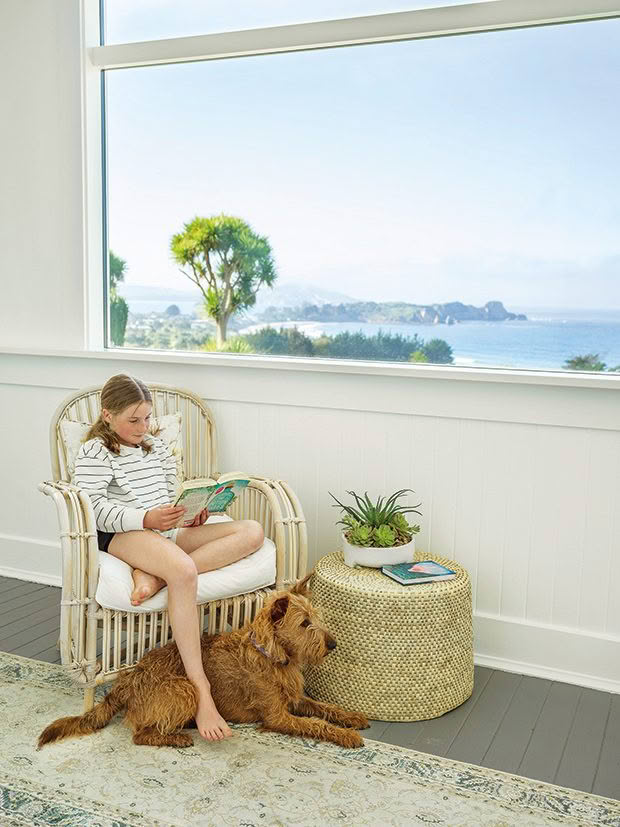
Vivienne with her canine foot warmer in one of the verandah’s many reading spots.
Was she chasing negative ions? “Absolutely. Walking barefoot on the beach is a great way to get grounded and reap the benefits of negative ionisation. It restores the balance in your autonomic nervous system, activating your parasympathetic nervous system.”
If Ilse sounds exceptionally knowledgeable about such things, it’s because, well, she is. Her own health scare kicked off in 2019 and was swiftly followed by the Covid-19 pandemic — a double whammy that caused her to re-evaluate the busy pace of the Erasmus life. “I think stress triggers real ‘dis-ease’ within the body, and it just got to the point where my body had had enough and wanted me to pay attention. That led to me embracing more intentional living.”
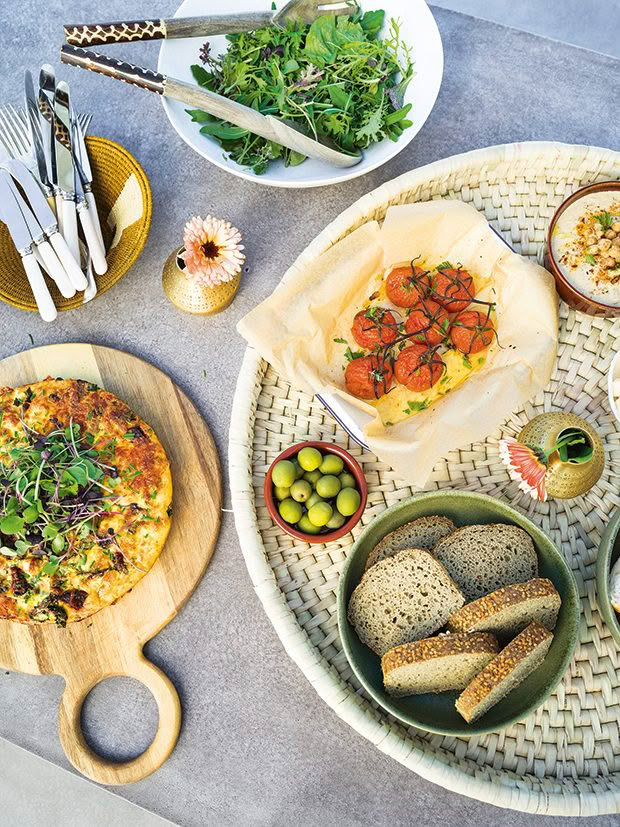
So Ilse pivoted career-wise and retrained as an integrative health coach and yoga teacher (her previous roles were in accounting, finance and the wine industry). She now helps others to pay attention to their overlooked bodies. It was as a result of this new career trajectory that Ilse’s radar was tuned to health-buoying coastal real estate. “I felt like there was a distinct lack of restorative places you could retreat to and slowly put your life back together again.”
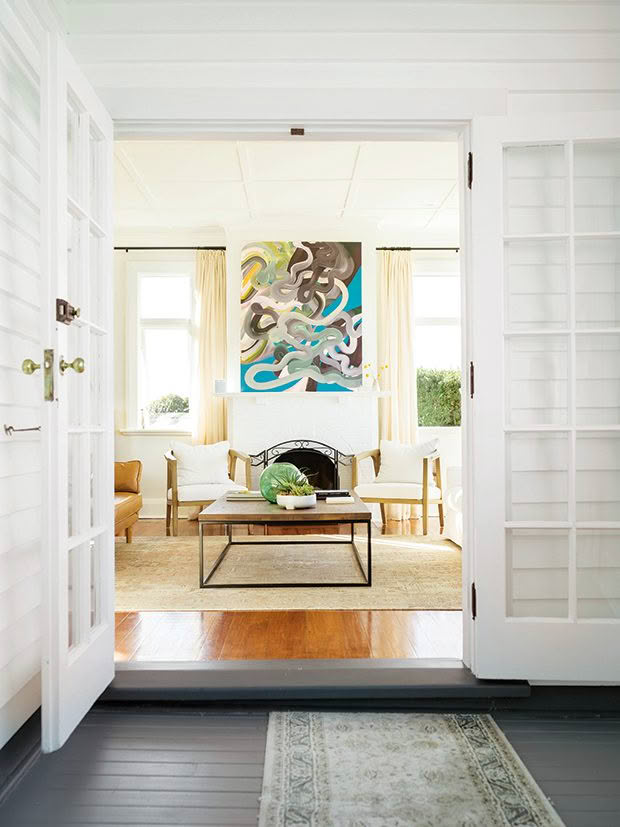
The Longhouse was a shoo-in. Ilse could see its potential as a base for bespoke health retreats, a venue for celebrations and events and for “slow stay” accommodation. She’s currently developing a seasonal wellness programme with a host of local practitioners (experts in the likes of yoga, meditation, aromatherapy, breathwork and nutrition) to promote intentional living. The Longhouse is back on the health beat.
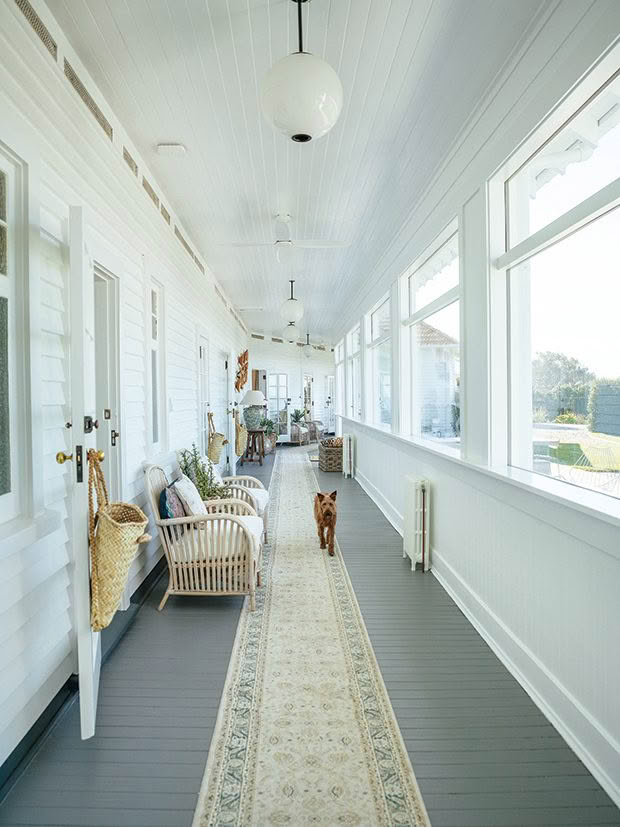
Irish terrier Elmo gets his steps up along the home’s 45-ish-metre enclosed verandah;
It took Ilse and Craig a year to complete the renovation work. They were keen to add structural brawn and internal beauty to the home while also remaining faithful to its humble aesthetics. “Maybe it’s because I’m an import from South Africa, but I’ve always had this love affair with old New Zealand timber houses. I like their humility.”
There was plenty of unglamorous remedial work to be done: they re-lined and re-wired the place, upgraded the insulation, added double-glazing and extra heating measures, lavished it with a bit of much-needed modern plumbing and moved the septic tank from its scene-stealing spot on the front lawn. They took pains to retain the original batten ceilings, tongue-and-groove panelling, heart rimu floors and fireplaces, and re-purposed doors and weatherboards where possible. “We’ve really tried to respect its old bones.”
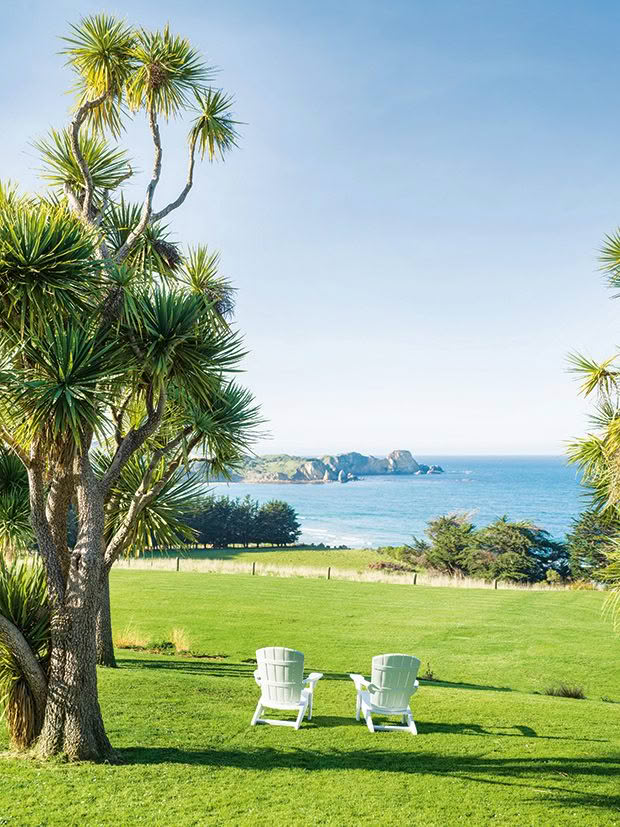
An unencumbered view from the property towards the Huriawa Peninsula.
Much of the décor is vintage or pre-loved so as not to startle the home’s gentle, 20th-century heart. Ilse aimed for a “barefoot luxe” vibe: an unfussy, cosy fitout with high-quality, sustainable materials. There’s a definite whiff of hygge here, too — the original Aga cooker is still in the kitchen reminiscing over slow meals past, while the newfangled hot tub, infrared sauna and firepit stand by for skin-warming duties.
- The lounge and bedroom interiors follow the same design ethic as the rest of the home.
- “We chose furnishings and décor based on their sustainability credentials,” says Ilse. “We’ve used environmentally-friendly oeko-tex certified-cotton linens in all the bedrooms, and the coir carpet is made from coconut husk.”
- Tintsaba weavers in Eswatini made the sisal baskets displayed on the wall.
Furnishing The Longhouse was a cinch for Ilse — she once co-owned a small interiors venture that sourced artisanal homewares from Africa, so she has a style-keen eye. One of her abiding décor principles is biophilic design. “It just reinforces that feeling of calm and being quite nurtured,” she says. “Biophilic design is all about bringing natural design inside. There are elements of biophilia throughout the interior spaces because this is what we deeply resonate with as a species.”
Just over half a hectare of land surrounds the house, yielding enough space for extensive gardens and landscaping. “For me, a place is never complete without the outdoor space,” says Ilse. “I wanted it to reinforce everything that’s happening inside the house. We’ve planted lots of natives, a fruit orchard and a kitchen garden. We wanted it to be serene.”
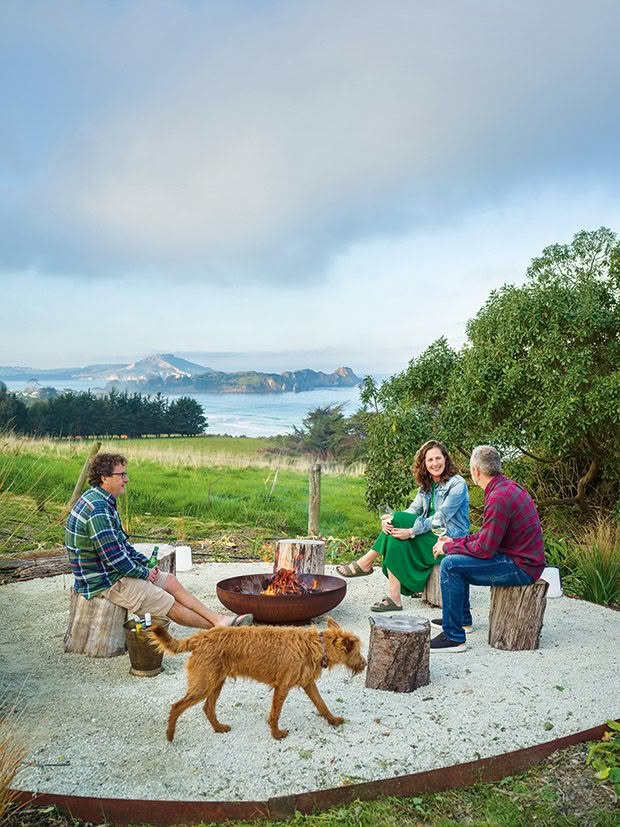
Craig and Ilse chat with a friend around the firepit while Elmo inserts himself into yet another photo.
Had the property fallen into indifferent hands when it came up for sale in 2021, this iconic 1920s structure and its early history of health promotion may well have been lost. But on Ilse’s watch, the home’s bella vista is still mending frayed nerves a century on. If Truby King were still alive, he’d likely be impressed with The Longhouse’s new biophilic-hygge skin. He may have been game for a bit of downward-facing dog on the front lawn, too.
ILSE’S BIG EPIPHANY
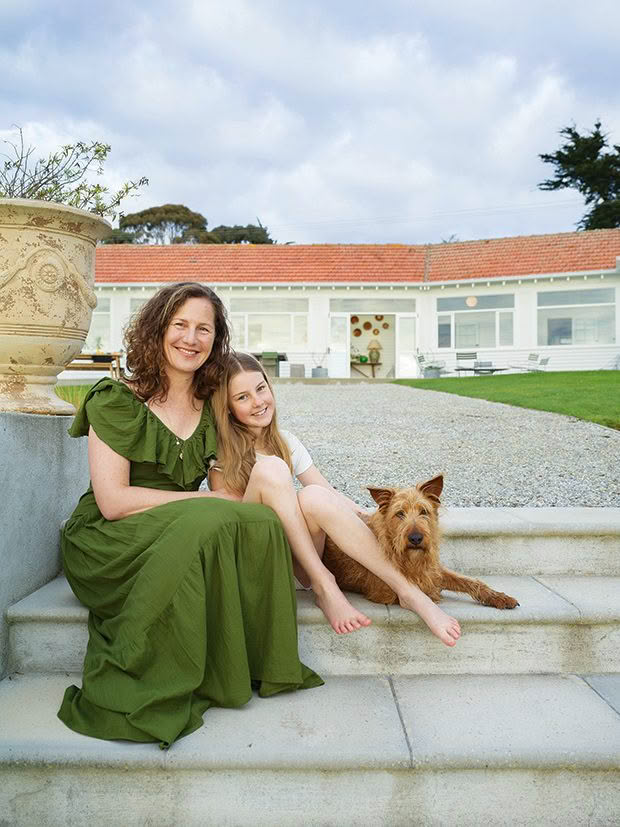
“When we had our family vineyard in Marlborough, I started to see the effects of conventional farming. That’s when my interest in organics, food production and human health really fermented and solidified. It was a turning point when I got sick in my early 40s. I discovered that 70 to 80 per cent of chronic diseases today result from our environment and lifestyle. From there, it was just a big awakening for me — a big epiphany. I’m now passionate about having conversations on how we embody wellness as a way of life in everything we do.
“As a society, I believe much of our ‘dis-ease’ is rooted in profound disconnection. For me, profound connection is all about eating organic whole foods, having a spiritual practice, taking the time to move our bodies and protecting white [mental] space so that we’re not constantly inundated.”
BIOPHILIC DESIGN
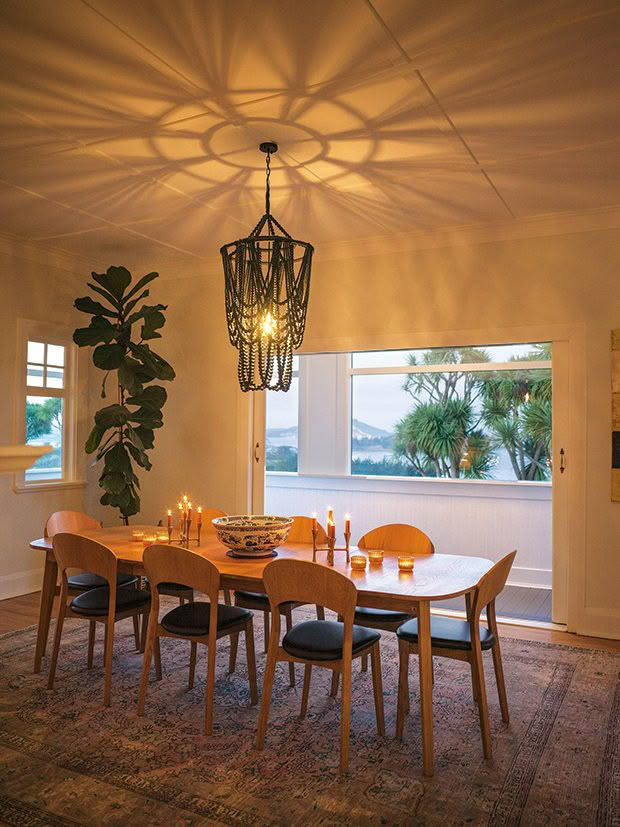
The dining room at dusk has sea and cabbage tree views. “That view doesn’t really dissipate from anywhere in the house,” says Ilse.
Biophilic design is a concept that stems from the term “biophilia” coined by biologist Edward O Wilson in the 1980s. He hypothesised that humans have an innate biology-led affinity for the natural world. Biophilic design applies this idea to the arrangement and fit-out of our built environment. It’s more than just a matter of plonking a cheerful pot plant here and there — it goes much deeper than that. It’s an ethos that seeks to impact mental and physical wellbeing by referencing, incorporating and mimicking nature.
Love this story? Subscribe now!
 This article first appeared in NZ Life & Leisure Magazine.
This article first appeared in NZ Life & Leisure Magazine.
